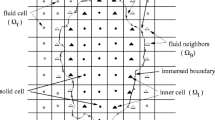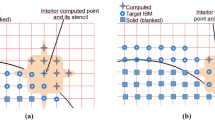Abstract
A simple second-order scheme on Cartesian grids for kinetic equations is presented, with emphasis on the accurate enforcement of wall boundary conditions on immersed bodies. This approach preserves at the discrete level the asymptotic limit towards Euler equations up to the wall, thus ensuring a smooth transition towards the hydrodynamic regime. We investigate exact, numerical and experimental test cases for the BGK model in order to assess the accuracy of the method.

























Similar content being viewed by others
References
Alaia, A., Puppo, G.: A hybrid method for hydrodynamic-kinetic flow—part II—coupling of hydrodynamic and kinetic models. J. Comput. Phys. 231(16), 5217–5242 (2012)
Ascher, U.M., Ruuth, S.J., Spiteri, R.J.: Implicit–explicit Runge–Kutta methods for time-dependent partial differential equations. Appl. Numer. Math. IMACS J. 25(2–3), 151–167 (1997)
Bennoune, M., Lemou, M., Mieussens, L.: Uniformly stable numerical schemes for the Boltzmann equation preserving the compressible Navier–Stokes asymptotics. J. Comput. Phys. 227(8), 3781–3803 (2008)
Bernard, F., Iollo, A., Puppo, G.: A local velocity grid approach for BGK equation. Commun. Comput. Phys. 16(4), 956–982 (2014)
Bhatnagar, P.L., Gross, E.P., Krook, M.: A model for collision processes in gases. I. Small amplitude processes in charged and neutral one-component systems. Phys. Rev. 94, 511–525 (1954). doi:10.1103/PhysRev.94.511
Bird, G.A.: Molecular Gas Dynamics and the Direct Simulation of Gas Flows. Oxford Engineering Science Series. Clarendon Press, Oxford (1994). http://books.google.it/books?id=Bya5QgAACAAJ
Cabannes, H., Gatignol, R., Luol, L.S.: The Discrete Boltzmann Equation. Lecture Notes at University of California, Berkley, pp. 1–65 (1980)
Cercignani, C.: The Boltzmann Equation and Its Applications. Springer-Verlag GmbH, Berlin (1988)
Chen, S., Xu, K., Lee, C., Cai, Q.: A unified gas kinetic scheme with moving mesh and velocity space adaptation. J. Comput. Phys. 231(20), 6643–6664 (2012)
Chu, C.K.: Kinetic-theoretic description of the formation of a shock wave. Phys. Fluids 8, 12–22 (1965)
Cisternino, M., Weynans, L.: A parallel second order Cartesian method for elliptic interface problems. Commun. Comput. Phys. 12(5), 1562–1587 (2012). doi:10.4208/cicp.160311.090112a
Degond, P., Jin, S., Mieussens, L.: A smooth transition model between kinetic and hydrodynamic equations. J. Comput. Phys. 209(1), 665–694 (2005)
Degond, P., Pareschi, L., Russo, G.: Modeling and Computational Methods for Kinetic Equations. Modeling and Simulation in Science, Engineering and Technology. Springer, Berlin (2004)
Dimarco, G., Pareschi, L.: Exponential Runge–Kutta methods for stiff kinetic equations. SIAM J. Numer. Anal. 49(5), 2057–2077 (2011)
Fedkiw, R.P.: Coupling an Eulerian fluid calculation to a Lagrangian solid calculation with the ghost fluid method. J. Comput. Phys. 175(1), 200–224 (2002)
Fedkiw, R.P., Aslam, T., Merriman, B., Osher, S.: A non-oscillatory Eulerian approach to interfaces in multimaterial flows (the ghost fluid method). J. Comput. Phys. 152(2), 457–492 (1999)
Filbet, F., Jin, S.: A class of asymptotic-preserving schemes for kinetic equations and related problems with stiff sources. J. Comput. Phys. 229(20), 7625–7648 (2010)
Filbet, F., Yang, C.: An inverse Lax–Wendroff method for boundary conditions applied to Boltzmann type models. J. Comput. Phys. 245, 43–61 (2013)
Gibou, F., Fedkiw, R.P., Cheng, L.T., Kang, M.: A second-order-accurate symmetric discretization of the Poisson equation on irregular domains. J. Comput. Phys. 176(1), 205–227 (2002)
Goodman, F.O., Wachman, H.Y.: Dynamics of Gas–Surface Scattering. Academic Press, New York (1976)
Gorsse, Y., Iollo, A., Telib, H., Weynans, L.: A simple second order Cartesian scheme for compressible Euler flows. J. Comput. Phys. 231(23), 7780–7794 (2012)
Ingram, D.M., Causon, D.M., Mingham, C.G.: Developments in Cartesian cut cell methods. Math. Comput. Simul. 61(3–6), 561–572 (2003)
Jiang, G.S., Shu, C.W.: Efficient implementation of weighted ENO schemes. J. Comput. Phys. 126(1), 202–228 (1996)
Jin, C., Xu, K.: A unified moving grid gas-kinetic method in Eulerian space for viscous flow computation. J. Comput. Phys. 222(1), 155–175 (2007)
Jin, S.: Efficient asymptotic-preserving (AP) schemes for some multiscale kinetic equations. SIAM J. Sci. Comput. 21(2), 441–454 (1999)
Jin, S.: Asymptotic preserving (AP) schemes for multiscale kinetic and hyperbolic equations: a review. Rivista di Matematica della Università di Parma. Serie 7 3(2), 177–216 (2012)
Karniadakis, G., Beskok, A., Aluru, N.: Microflows and Nanoflows: Fundamentals and Simulation. Springer, Berlin (2005)
Kennedy, C.A., Carpenter, M.H.: Additive Runge–Kutta schemes for convection–diffusion–reaction equations. Appl. Numer. Math. 44(1–2), 139–181 (2003)
Latvala, E.K., Anderson, T.P.: Experimental Determination of Jet Spreading from Supersonic Nozzles at High Altitudes. AEDC-TN-58-98 (ASTIA Document No. AD-208546) (1959)
Latvala, E.K., Anderson, T.P.: Studies of the spreading of rocket exhaust jets at high altitudes. Planet. Space Sci. 4, 77–91 (1961)
Mieussens, L.: Discrete-velocity models and numerical schemes for the Boltzmann–BGK equation in plane and axisymmetric geometries. J. Comput. Phys. 162(2), 429–466 (2000)
Osher, S., Sethian, J.A.: Fronts propagating with curvature-dependent speed: algorithms based on Hamilton–Jacobi formulations. J. Comput. Phys. 79(12), 12–49 (1988)
Pareschi, L., Russo, G.: Implicit–explicit Runge–Kutta schemes and applications to hyperbolic systems with relaxation. J. Sci. Comput. 25(1), 129–155 (2005)
Pareschi, L., Russo, G.: Efficient Asymptotic Preserving Deterministic Methods for the Boltzmann Equation. Models and Computational Methods for Rarefied Flows, AVT-194 RTO AVT/VKI, Rhode St. Genese, Belgium (2011)
Peskin, C.S.: Flow patterns around heart valves: a numerical method. J. Comput. Phys. 10(2), 252–271 (1972). doi:10.1016/0021-9991(72)90065-4. http://www.sciencedirect.com/science/article/pii/0021999172900654
Pieraccini, S., Puppo, G.: Implicit–explicit schemes for BGK kinetic equations. J. Sci. Comput. 32(1), 1–28 (2007)
Pieraccini, S., Puppo, G.: Microscopically implicit-macroscopically explicit schemes for the BGK equation. J. Comput. Phys. 231, 299–327 (2012)
Sethian, J.A.: Fast marching methods. SIAM Rev. 41, 199–235 (1999)
Shapiro, A.: The Dynamics and Thermodynamics of Compressible Fluid Flow. Ronald Press, New York (1953)
Tiwari, S., Klar, A.: An adaptive domain decomposition procedure for Boltzmann and Euler equations. J. Comput. Appl. Math. 90, 223–237 (1998)
Xu, K., Huang, J.C.: A unified gas-kinetic scheme for continuum and rarefied flows. J. Comput. Phys. 229(20), 7747–7764 (2010)
Yang, G., Causon, D., Ingram, D., Saunders, R., Batten, P.: A Cartesian cut cell method for compressible flows. Part A. Static body problems. Aeronaut. J. 101, 47–56 (1997)
Acknowledgments
Experiments presented in this paper were carried out using the PlaFRIM experimental testbed, being developed under the Inria PlaFRIM development action with support from LABRI and IMB and other entities: Conseil Régional d’Aquitaine, FeDER, Université de Bordeaux and CNRS (see https://plafrim.bordeaux.inria.fr/). This study has been carried out with financial support from the French State, managed by the French National Research Agency (ANR) in the frame of the “Investments for the future” Programme IdEx Bordeaux (ANR-10-IDEX-03-02), Cluster of excellence CPU. Gabriella PUPPO acknowledges the contribution of PRIN Project 2009, No, 2009588FHJ_002.
Author information
Authors and Affiliations
Corresponding author
Appendix
Appendix
We present the Newton–Raphson algorithm to compute the discrete Maxwellian distribution function. The first three moments of the distribution functions are known and we define the collision invariant \(\mathbf{m }(\varvec{\xi })=(1,\varvec{\xi },\frac{1}{2}|\varvec{\xi }|^{2})^{T}\). The Maxwellian distribution function \(M_{f}\) is computed such that, with the given quadrature rule:
where \((\rho ,\rho \mathbf{U },E)=\langle f,\mathbf{m }(f)\rangle \), that is the moments are computed from \(f\) approximately, using the given quadrature rule.
We are looking for \(M_{f}\) under the form: \(M_{f}=\text{ exp }(\varvec{\alpha }\cdot \mathbf{m }(\varvec{\xi }))\). Let us define the function:
with \(\underline{\varvec{\rho }}=(\rho ,\mathbf{U },E)^{T}\), the macroscopic variables computed from the moments of \(f\). The discrete Maxwellian verifies \(\mathbf{F }(\varvec{\alpha })=0\). Thus, the problem of computing the discrete Maxwellian reduces to find \(\varvec{\alpha }\) such that \(\mathbf{F }(\varvec{\alpha })=0\). This is done with a Newton–Raphson algorithm. The initial value of \(\varvec{\alpha }\) corresponds to the continuous Maxwellian:
The algorithm is summarized as follows:

In the case of the reduced models, the algorithm is identical but the function \(\mathbf{F }\) is defined as:
where \(\mathbf{e }_{3}=(0,0,1)^{T},\,\mathbf{e }_{4}=(0,0,0,1)^{T},\,\mathbf{m }_{1}(\varvec{\xi })=(1,\xi _{u},\frac{1}{2}|\xi _{u}|^{2})^{T},\,\mathbf{m }_{2}(\varvec{\xi })=(1,\xi _{u},\xi _{v},\frac{1}{2}(\xi _{u}^{2}+\xi _{v}^{2}))^{T}\). And:
The Newton–Raphson algorithm give the expression of \(\widetilde{M_{\phi }}\). \(\widetilde{M_{\psi }}\) is then easily computed with the formula:
Rights and permissions
About this article
Cite this article
Bernard, F., Iollo, A. & Puppo, G. Accurate Asymptotic Preserving Boundary Conditions for Kinetic Equations on Cartesian Grids. J Sci Comput 65, 735–766 (2015). https://doi.org/10.1007/s10915-015-9984-8
Received:
Revised:
Accepted:
Published:
Issue Date:
DOI: https://doi.org/10.1007/s10915-015-9984-8




